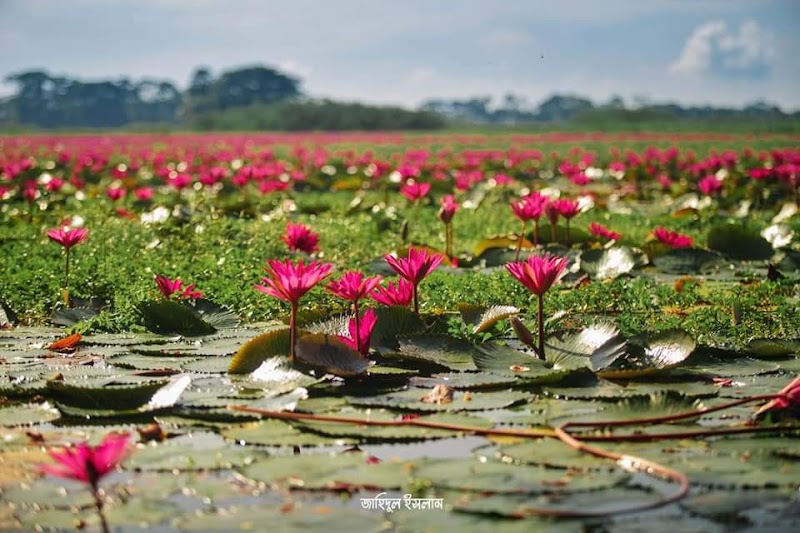
Tongi Boishakhi Mela: The Vibrant Pulse of Bengali New Year in Dhaka Division
Tongi Boishakhi Mela lights up each April with a burst of Bengali New Year celebrations full of color, music, and tradition. This festival brings the vibrant culture of Tongi alive, offering an accessible yet immersive experience for visitors seeking both festivity and insight.
Arrive Early to Avoid Peak Crowds
The festival grows intensely crowded after noon. Plan to arrive at opening time to explore comfortably and enjoy performances without being overwhelmed.
Wear Comfortable, Closed-Toe Footwear
Expect dusty, uneven terrain with heavy foot traffic. Durable shoes will protect your feet and provide stable footing during long hours of walking and standing.
Stay Hydrated and Carry a Water Bottle
April in Dhaka Division is warm and humid. Frequent hydration breaks are critical to avoid heat exhaustion amidst the packed crowd and sunny conditions.
Prepare a Cash-Only Budget
Most vendors operate on cash transactions, especially smaller food and craft stalls. Carry sufficient local currency to ease purchases and bargaining.
Tongi Boishakhi Mela: The Vibrant Pulse of Bengali New Year in Dhaka Division
The Tongi Boishakhi Mela in Tongi, Dhaka Division is more than just a festival—it's a day where the city bursts with color, music, and tradition, marking the arrival of Bengali New Year with unbridled enthusiasm. From dawn till dusk, the fairground hums with energy, drawing locals and visitors alike into a whirlwind of cultural performances, street food stalls, and artisan crafts.
Arrival in Tongi places you right at the heart of a celebration fiercely alive with history and communal spirit. The festival sprawls across open fields and packed streets where traditional folk dances challenge the air to keep pace, and vibrant hues splash the sky on the dancers’ swirling saris and punjabi. The smell of pitha and roasted corn lures you from one vendor to another, each promising an authentic taste of Bengali heritage.
Planning your visit? Tongi Boishakhi Mela thrives in the spring sun of mid-April, coinciding exactly with Pohela Boishakh, the Bengali New Year’s Day. Getting there early is essential: the crowds swell by midday, making navigation through the maze of stalls and stages a test of patience and endurance. Comfortable, sturdy footwear is a must as the terrain alternates between dusty paths and uneven patches of grass, relentlessly stamped by thousands of feet.
Beyond the surface, the fair is a lively exchange of tradition and progress. Local craftsmen display their skills, from bamboo work to hand-woven fabrics, inviting questions, and eye-catching souvenirs. Don’t miss the photo opportunity at the colorful gateways decorated with floral designs and motifs that tell the story of Bangladeshi culture.
Hydration is non-negotiable here—the energetic celebrations under a growing sun demand frequent water breaks, and vendors are readily available. The melodic calls of folk instruments seem to dare you to keep pace, while the rhythmic steps of dancers push the crowd forward, weaving through the vibrant chaos.
Tongi Boishakhi Mela stands as a testament to a community's resilience and joy. It’s a vibrant, unfiltered experience that invites you to engage with every sense but warns patience—intense crowds and heat are constant challenges. Treat the festival as an immersive journey, a practical adventure that excites without glossing over the realities of its scale and pace. For those eager to witness a living tradition, Tongi’s Boishakhi Mela offers a memorable, practical celebration that is firmly rooted in everyday life and cultural pride.
Nearby Trips
All Adventures
Boat Charters
Water Activities
Adventures near Tongi, Dhaka Division
Discover the unique and memorable adventures that make Tongi, Dhaka Division special.
Frequently Asked Questions
What is the historical significance of the Tongi Boishakhi Mela?
The festival celebrates Pohela Boishakh, the Bengali New Year, an event rooted in agrarian traditions that marks a new cycle of harvest and prosperity. In Tongi, it also symbolizes local cultural pride and community unity.
Are there any lesser-known attractions within the festival grounds?
Look for traditional puppet shows and local folk storytelling tents often set away from the main stages. These offer intimate cultural experiences less crowded than central events.
Is the festival family-friendly?
Yes, the festival offers activities and food stalls suitable for children. However, parents should be mindful of crowd density and ensure small children stay close.
What local wildlife might be seen near Tongi during the festival?
While the festival takes place in an urban setting, nearby patches of green may reveal common birds like the koel and parakeets, whose calls mix into the festive soundscape.
Are there environmental considerations visitors should be aware of?
Waste management can be challenging during large gatherings. Visitors are encouraged to minimize plastic use, dispose of trash responsibly, and support initiatives promoting festival cleanliness.
What photography tips would help capture the festival atmosphere?
Early morning light offers crisp, shadowed shots of the festival’s colorful decorations and less congested streets. Capture wide shots of dance performances and close-ups of artisans at work for diverse imagery.
Recommended Gear
Comfortable Walking Shoes
Protects feet against uneven ground and extended standing times.
Reusable Water Bottle
Keeps you hydrated during the warm, crowded festival activities.
Lightweight Sunscreen
Protects your skin during prolonged outdoor exposure under April’s sun.
Cash in Local Currency
Most vendors accept only cash, so bring enough for food and souvenirs.
Local Insights
Hidden Gems
- "The puppet theater and folk storytelling corners on the festival's north edge"
- "Small artisan tents featuring bamboo and clay crafts"
Wildlife
- "Indian koel bird – their distinct calls blend into the festival noise"
- "Rose-ringed parakeet – often spotted in nearby trees"
History
"The Tongi Boishakhi Mela reflects a blend of agrarian Bengali heritage and modern urban celebration, highlighting centuries-old New Year traditions evolving in a fast-growing city landscape."
